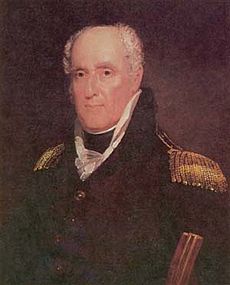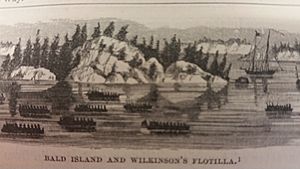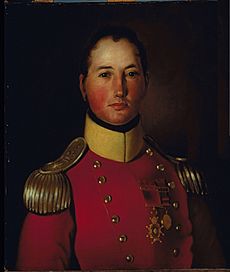Battle of Crysler's Farm facts for kids
Quick facts for kids Battle of Crysler's Farm |
|||||||
|---|---|---|---|---|---|---|---|
| Part of the War of 1812 | |||||||
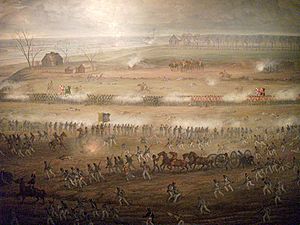 Battle of Crysler’s Farm, Unknown artist |
|||||||
|
|||||||
| Belligerents | |||||||
| Commanders and leaders | |||||||
| Strength | |||||||
| 900 | 8,000 | ||||||
| Casualties and losses | |||||||
| 192 killed, wounded or missing | 359 killed, wounded or missing | ||||||
The Battle of Crysler's Farm was a major fight during the War of 1812. It happened on November 11, 1813. A smaller force of British and Canadian soldiers won a big victory. They fought against a much larger United States army. This defeat made the US army give up their plan to capture Montreal. This battle was a key moment in the autumn of 1813.
Contents
Why the Battle Happened: The St. Lawrence Campaign
The Battle of Crysler's Farm was part of a bigger plan. The United States wanted to capture the city of Montreal in Canada. This whole effort was called the St. Lawrence Campaign. It included other battles and small fights.
The American Plan to Attack Montreal
The US plan was created by John Armstrong Jr., the Secretary of War. He first thought about leading the attack himself. The plan involved two US armies joining together.
- Major General James Wilkinson would lead 8,000 soldiers. They would travel down the Saint Lawrence River in small boats.
- Major General Wade Hampton would lead 4,000 soldiers. They would march north from Plattsburgh.
The two armies were supposed to meet and then attack Montreal.
However, there were many problems with this plan.
- The US Navy commander, Isaac Chauncey, refused to attack Kingston. This was a British naval base.
- The US generals, Wilkinson and Hampton, did not trust each other. Hampton even refused to work with Wilkinson at first.
- The US soldiers were not well trained. They lacked uniforms and many were sick.
- The armies did not have enough supplies for a long fight in Montreal.
Early Moves by the Americans
Hampton started his part of the campaign on September 19. He moved his troops down the Richelieu River. But he found the British defenses too strong. So, he moved west to the Chateauguay River. He had to wait there for Wilkinson's army. This delay cost him soldiers and supplies.
Wilkinson's army was also delayed. He was supposed to start on September 15. But he was ill and stayed near Fort George for almost a month. His army finally began moving in early October.
Because of all these problems, Secretary Armstrong decided not to lead the attack. He gave Wilkinson full command. Armstrong left on October 16. Hampton's army fought the Battle of the Chateauguay on October 26. Even though he attacked, Hampton's forces were pushed back. He then resigned and retreated.
Wilkinson's Journey Down the River
Wilkinson's army left Sackett's Harbor on October 17. They traveled in about 300 small boats. It was late in the year for fighting. The weather was bad, and many soldiers got sick.
On November 1, the first boats reached French Creek. Here, British ships under Commander William Mulcaster attacked them. The British ships were escorting supplies. The next morning, American cannons fired "hot shot" at the British ships. This forced them to leave.
On November 6, Wilkinson heard that Hampton had been defeated at Chateauguay. He sent new orders for Hampton to meet him at Cornwall.
Wilkinson's army passed the British post at Prescott on November 7. The soldiers marched around it on land. The empty boats sailed past the British cannons at night. Only one boat was lost. The next day, some American soldiers landed on the Canadian side. They cleared the river bank of Canadian militia.
On November 9, Wilkinson held a meeting with his officers. They all decided to continue the mission. An advance group of 2,500 soldiers marched along the north bank of the river. They cleared a small British fort. Wilkinson then learned that a British force was chasing him. He landed most of his other troops as a rearguard. This group was led by Brigadier General John Parker Boyd. On November 10, Boyd's troops set up camp near Cook's Tavern. They had been marching under fire from British boats.
British Response to the American Advance
The British knew the Americans were gathering. They first thought the Americans would attack their naval base at Kingston. But when Mulcaster returned on November 5, he reported that the Americans were heading down the Saint Lawrence. Major General Francis de Rottenburg sent a group of soldiers to follow them.
This group had 650 men. It was led by Lieutenant Colonel Joseph Wanton Morrison. They sailed from Kingston on November 7. On November 9, they reached Prescott. There, Morrison's force grew to about 900 men.
The British marched quickly. They caught up with Boyd's American rearguard on November 10. That evening, they camped near Crysler's Farm. This was two miles upstream from the American positions. The area was open fields, which was good for British fighting tactics. The muddy ground and marshy woods would make it hard for the Americans to move. Morrison was ready to fight here.
The Battle of Crysler's Farm
On November 11, it was cold and raining at dawn. Fighting started in two places. British gunboats fired at American boats on the river. On land, a Mohawk warrior fired at an American scouting party. This led to both sides getting ready for battle.
Around 10:30 AM, Wilkinson decided to attack the British. He was ill and could not lead the attack himself. His second-in-command was also sick. So, Brigadier General Boyd took command. Boyd had about 2,500 soldiers ready to fight.
How the British Were Set Up
The British army was spread out in a special way.
- On the left, near the woods, were skirmishers. These were Canadian Voltigeurs and Mohawks.
- On the right, near the river, were soldiers from Prescott. They had a cannon.
- Behind them were more soldiers from the 2nd/89th Regiment.
- The main British force was in the middle. It included the 49th Regiment and more of the 2nd/89th.
- Two British cannons were on a small hill. They fired over the heads of their own soldiers.
The Fighting Begins
Boyd ordered the attack in the afternoon. On the American right, soldiers pushed the British skirmishers back through the woods. They were joined by more American troops. But then they saw a line of British redcoats (the 2nd/89th Regiment) rise up and fire. The American attack lost its power. Soldiers hid behind trees and started to retreat as they ran out of ammunition.
Meanwhile, another American group, Covington's brigade, moved forward. They faced heavy fire. General Covington was badly wounded and died. His second-in-command was also killed. The brigade quickly lost order and began to retreat.
The American cannons started firing from the road. They were very effective. The British 49th Regiment was ordered to capture them. They charged, facing heavy fire from the American guns. The US Dragoons (cavalry) then charged the side of the 49th Regiment. The 49th stopped their charge and turned to fight the dragoons. The dragoons charged twice more but had to fall back. They lost many men. This gave time for the Americans to remove all but one of their cannons. The British captured the last cannon.
By 4:30 PM, most of the American army was retreating. They went back to their boats and crossed to the south side of the river. The British stopped their advance as it was getting dark and stormy.
Who Was Hurt?
The British reported 31 killed, 148 wounded, and 13 missing. The Americans reported 102 killed and 237 wounded, including General Covington. They also lost 120 prisoners. Most of these were wounded soldiers left on the battlefield.
What Happened After the Battle
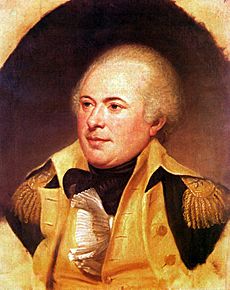
On November 12, the American boats successfully passed some dangerous rapids. They reached a settlement near Cornwall. There, they met up with Brown's soldiers. But there was no sign of Hampton's army. Hampton sent a message saying he had to retreat due to lack of supplies. Wilkinson used this as a reason to end the campaign.
The defeat at Crysler's Farm and the earlier Battle of the Chateauguay stopped the American threat to Montreal in 1813. This meant Canada was safe from being cut in half.
The American army went into winter camps. Wilkinson was later removed from command. He faced a court martial but was cleared. Other American officers were either retired or promoted.
On the British side, Commander Mulcaster was promoted but lost a leg in another battle. Lieutenant Colonel Morrison was also badly wounded later. Many British officers involved in the battle later became generals.
Remembering the Battle
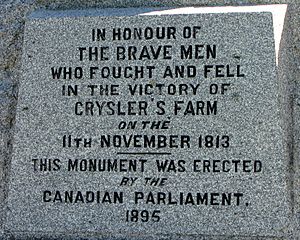
In 1895, a monument was put up at the battle site. In 1920, the site was named a National Historic Site of Canada. A plaque was added in 1921.
The original Crysler's Farm area was flooded in 1958. This happened because of the building of the Moses-Saunders Power Dam for the St. Lawrence Seaway. The monument was moved to Crysler’s Farm Battlefield Park in Morrisburg.
Today, some US Army units still carry the history of the regiments that fought in this battle. The British Army does not have a special honor for Crysler's Farm. However, three Canadian Army regiments do have the "Crysler's Farm" Battle Honour. This was given in 2012. It remembers the importance of the battle for Canada's defense. It also honors the soldiers who fought there.
On November 11, 2013, the 200th anniversary of the battle, Prime Minister Stephen Harper visited the park. He laid a wreath to honor those who fought. American and British representatives also attended.


